Design Workshop: Getting a Feel for Steel
The Arts & Crafts movement in architecture of the late 19th and early 20th centuries proposed a departure from excess ornament and a return to truth in material, a celebration of the ordinary textures and qualities inherent in a material. This concept remains a powerful influence on modern residential architecture and design today. And steel happens to be one of the materials most outwardly expressive of this concept.
Quintessentially modern, steel is a material born of industrial processes. It’s forged in fire and rolled or drawn into shapes — beams, tubes, wires, angles, plates. Steel is strong, durable, conductive, ductile, machinable and malleable. And while many think of the use of steel in a residential setting as a particularly cold form of modernism, steel can be wonderfully warm and inviting when contrasted with natural materials.
Let's examine some of the characteristics of steel and how it might be applied to your project truthfully.
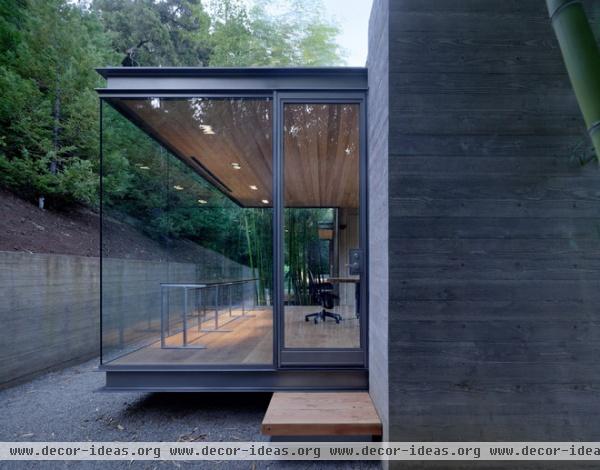
Strength
The way steel is shaped — whether it's cold rolled or hot rolled — influences its ultimate strength. Cold rolling hardens steel, aligning the carbon fibers, while hot rolling yields the same industrial character at a lower cost.
One of steel's primary architectural assets is its ability to create large unsupported spans and cantilevers. This glass tea house hovers over the garden below and is made possible by the rigidity of the steel structure supporting the floor and roof plates. The thickness of structural elements using steel for support can be reduced to bare minimums, leaving thin planes to define space.
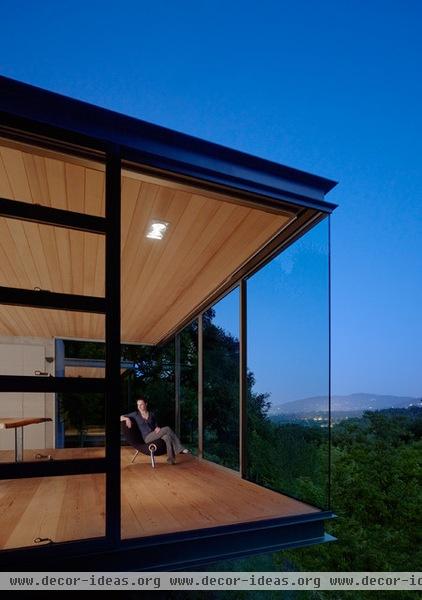
The roof edge expresses very simply the delicate nature of the structure. Using commonly milled steel shapes such as the channel or C-shape at this roof edge is a hallmark truth-in-material gesture. It respects the true nature of steel's industrial lineage and emphasizes the lightness of the roof plane.
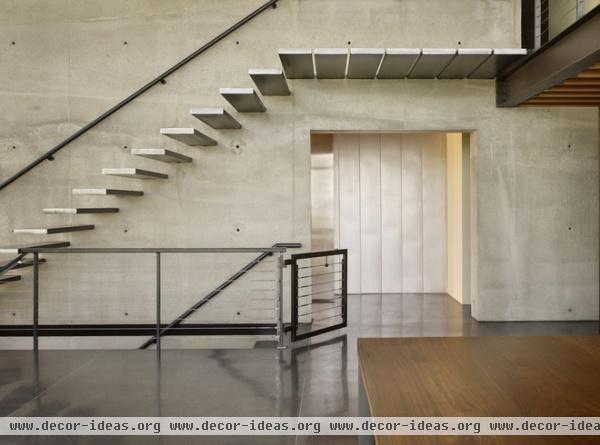
Defying gravity, this stair's 4-foot cantilever is made possible by steel's tensile strength and by welding the treads to embedded steel plates in the concrete wall.
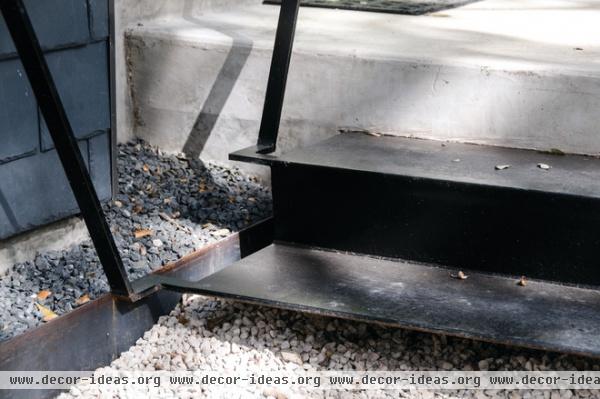
Weight
Much of the beauty of steel is derived from its strength relative to its size or thickness. Because steel is sold by the pound, designers often seek to use the most economical section or weight of steel for the loads involved. This steel stair tread, riser and railing showcase the lightness that is possible with steel. The stair appears to float in this instance, and the delicate verticals supporting the handrail appear as folded origami paper.
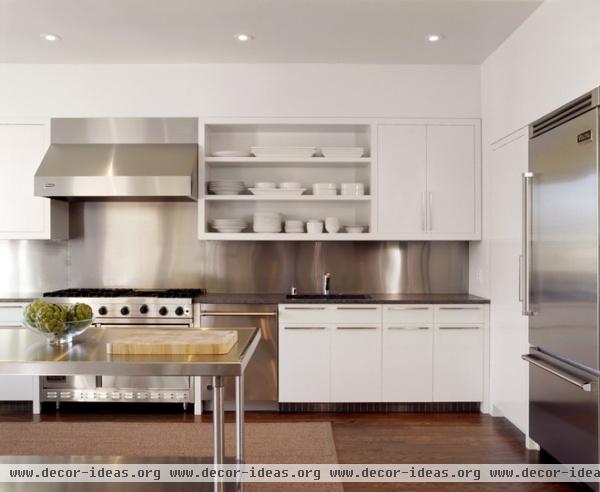
Durability
While steel is naturally an extremely durable material, alloys can be even more durable. Stainless steel is a mix of chromium (and other elements in varying proportions) and steel; the result is a highly resilient, corrosion-resistant surface. When exposed to air, the chromium creates an invisible oxide layer on the surface, which protects the steel. It also gives it the characteristic deep luster.
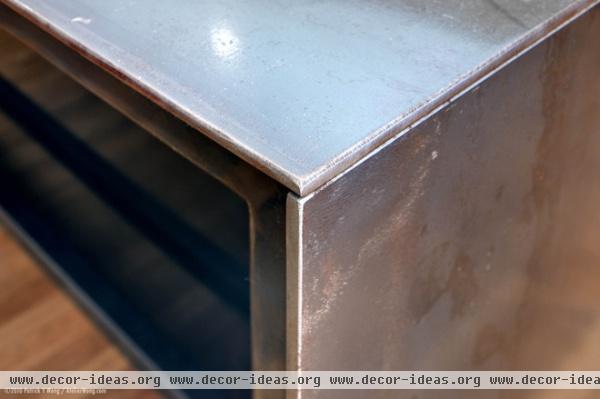
Appearance
Cold-rolled steel is more finished and tailored; hot-rolled steel is casual, rugged and less refined. This counter, made from ¼-inch hot-rolled steel plate, proudly displays the mill scale (oxidation from the cooling process) as ornament. The raw industrial character is reinforced by the simple connection detail at the corner. In this kitchen the massive island is a focal point and a contrasting element in the overall room composition.
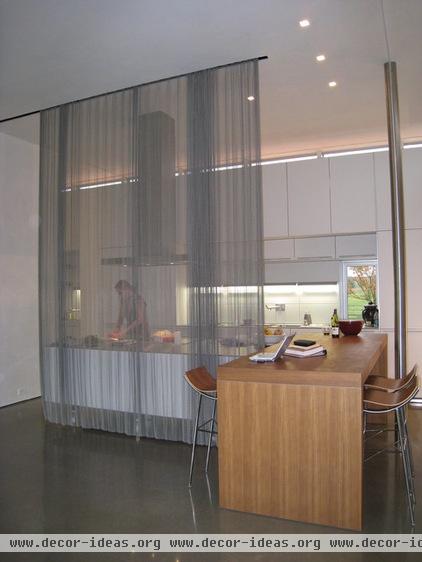
Lightness
Steel can also be extremely light and airy. This metal fabric consists of round weaves of steel wire. Varying the gauge and weave size of the wire makes the fabric more or less transparent. These fabrics can make for monumental room dividers, sun shades or even shower curtains.
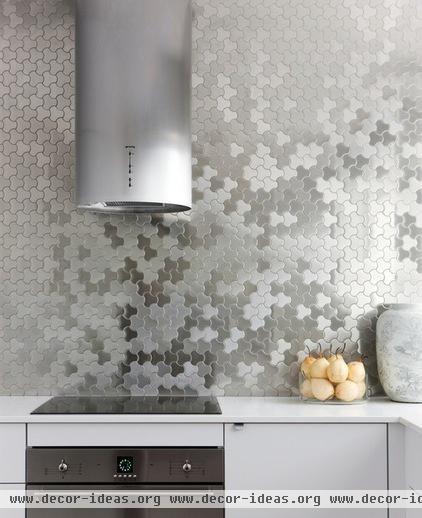
Finishes
Steel can be machined and finished in a variety of ways. By varying the luster of the individual tiles in this kitchen, from brushed to mirrored and matte, the architect has created a subtle, tonally varied and geometrically organic surface. An excellent material choice for a backsplash, steel is heat and stain resistant and can be easily cleaned.
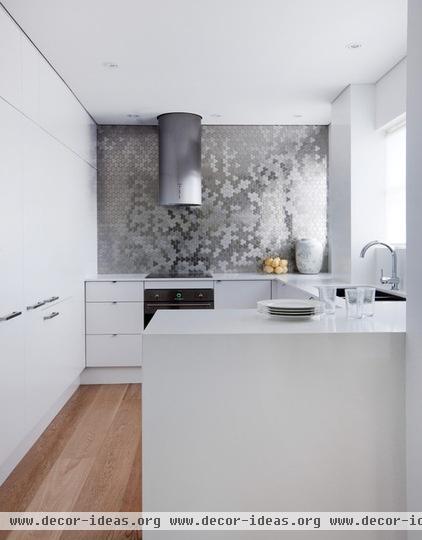
The cold gray of steel can be balanced by warmer tones, such as the wood floor in this kitchen. Tonally, the two materials complement each other here — one anchors the floor; the other, the wall. Note the tonal variety in each of the surfaces as well. The graining of the wood and the varied finishes on the tile complement each other.
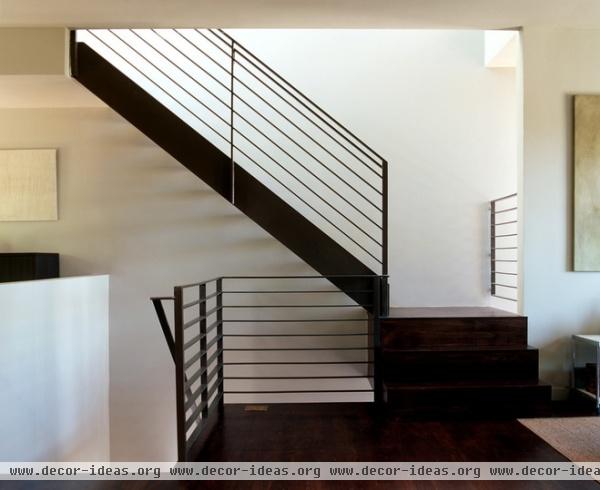
More Steel Treatments
Blackening. The surface of steel can be chemically altered in other ways. Blackening is a process in which the steel surface is coated in black oxide to protect it from rust (red oxide) and corrosion. This delivers a look similar to that of wrought iron, but more precise and without iron's brittleness. The thin black lines of the steel railing against the white wall make for a delicate, minimalist and sculptural stair here.
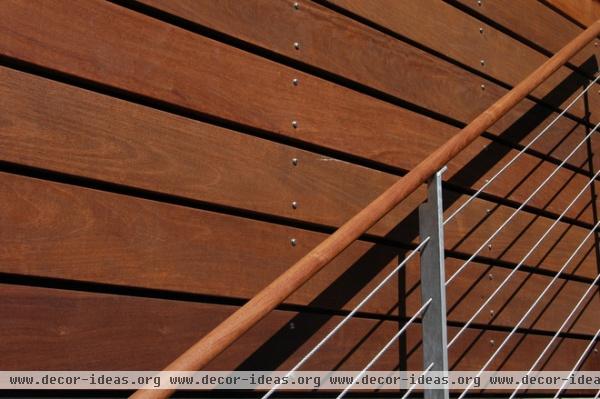
Galvanizing. Dipping steel in zinc creates a corrosion-resistant layer bonded to the top layer of steel. This mottled gray finish appears more casual, camp-like and unpretentious than other corrosion-resistant options, like stainless steel. The soft gray lines of the stair guard contrast the shadowed reveals of the siding.
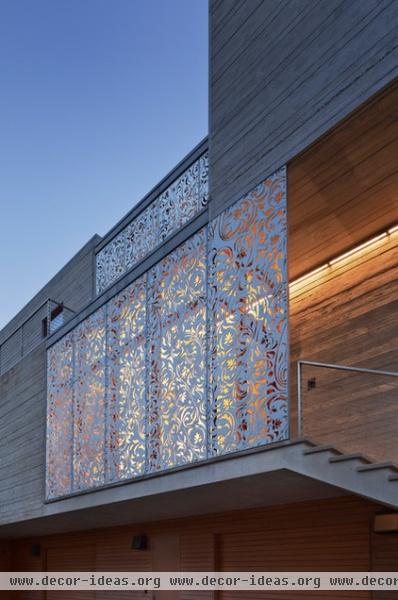
Cutting. Steel is uniquely suited to receive elaborate stencil-like treatments, like the ones seen here. Its methods of production (extreme heat and pressure) mean it's open to fabrication techniques not available to less-durable materials.
This pattern was cut into a ⅜-inch-thick steel screen by a computer-controlled water-jet cutting machine. Architecturally it creates an exterior screened entry area; but it also creates an ever-changing texture of light and shadow on the interior. In this screen the steel's tensile strength is conserved in spite of the relatively open organic pattern.
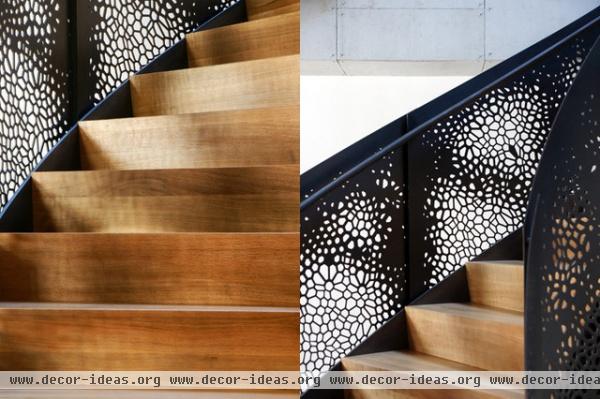
Steel sections must be thin to permit laser-cut details. The tree-branch patterning and spiral geometry here invoke an interesting dialogue between abstract natural allusions and the inorganic character of this highly machined material. Tonal contrasts between the wood and steel further accentuate this interplay.
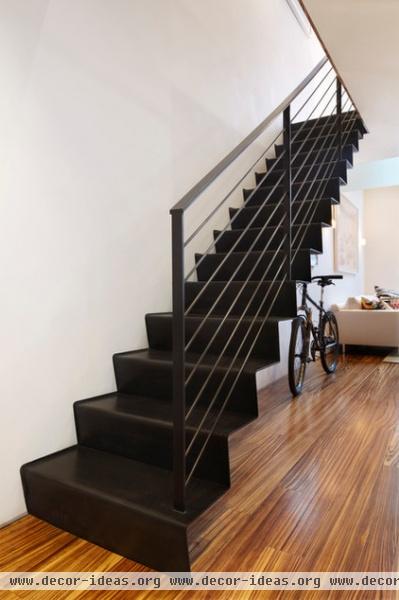
Folding. Altering the shape of steel can expand its spanning capability. Similar to the Roman arch, the shape here distributes the loads more efficiently. Because the thin plates comprising this cantilevered stair are folded, they're rigid enough to span large distances.
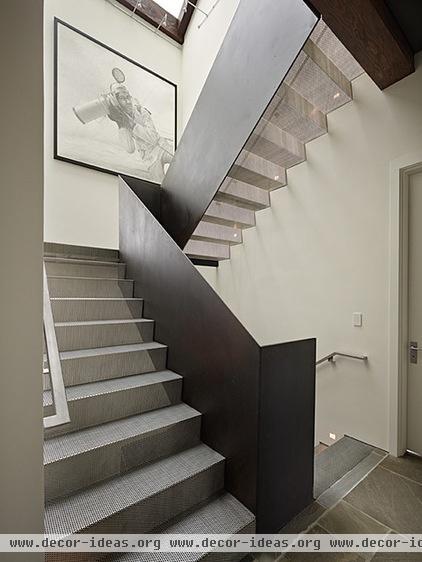
The architect here created a light-filled stair tower by using thin folded plates of steel to support the perforated metal treads. The folding reinforces the stair assembly and doubles as a guardrail — and makes the stair an art object.
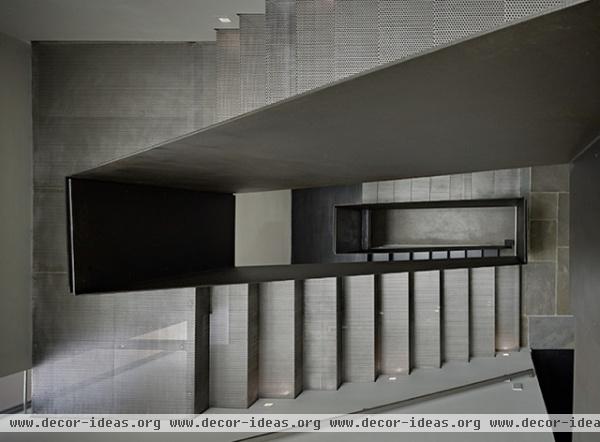
Perforated stainless steel treads and risers disappear into the wall here, reinforcing the lightness of the composition. The folded steel plate and treads each assert different weightless characteristics as the viewing angle changes. When viewed from the side, the blackened steel guard sculpturally anchors the vertical volume of space. When viewed from above, it virtually disappears, forming a thin black line chasing downward. Contrasting the darker steel, the lighter treads and risers cascade from above like water, forming a gauze-like scrim.
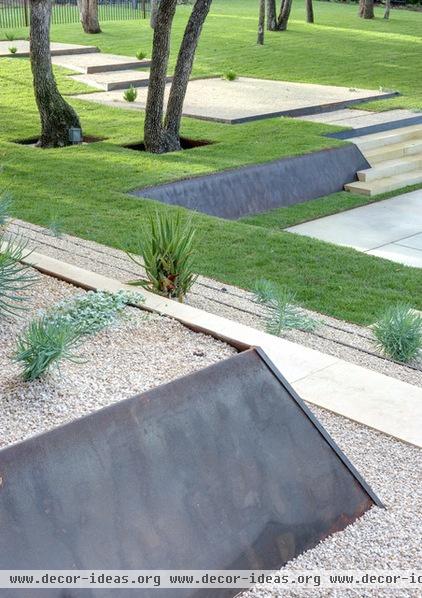
Outdoor Uses
Because it's a durable, naturally weathering material, steel can also be used in landscapes. Richard Serra's sculptures, made of weathering steel, are fitting examples. The architects here have used it as a clean edge to define terraces and negotiate changes in elevation. Note the crisp edges and intentional battering of the vertical planes.
Battering the retaining walls this way makes for a stronger wall, as the overturning force is greatest at the base, and the wall is positioned in a way to restrain that force. True in material and form, the steel becomes another texture and color in the landscape, highlighting an intentionally engineered intervention.
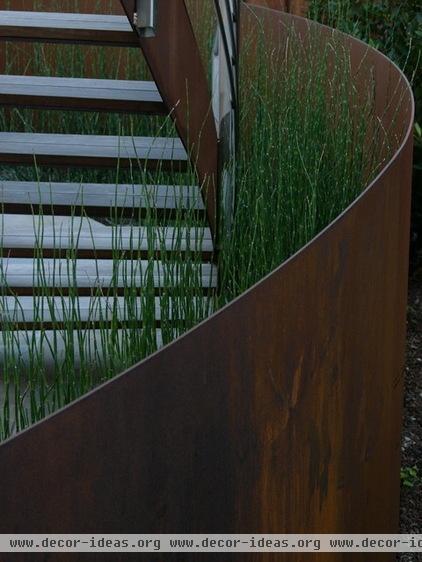
While it's not uncommon to see steel in warm and cool grays, it can also wear a broader variety of saturated hues, especially when used untreated in the outdoors. Cor-Ten, as used for the plate here, oxidizes naturally. Its color is dependent on the climate and can turn bright orange, dark brown, deep red and even purple.
I hope all of these expressions of steel inspire new and meaningful uses in your projects.
More: Explore other ways to design with metal












